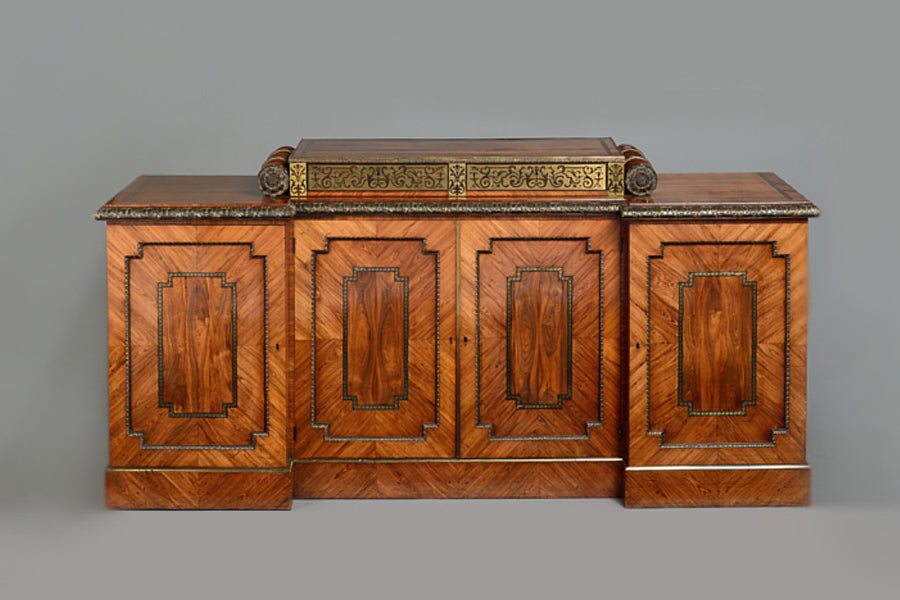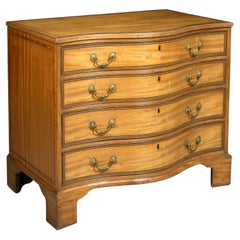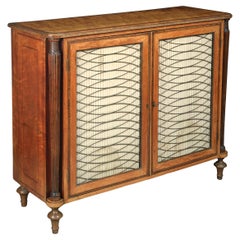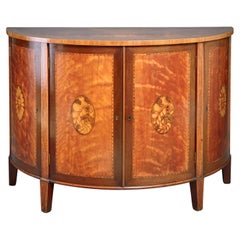Want more images or videos?
Request additional images or videos from the seller
1 of 9
Pair of George III Satinwood Card-Tables
$15,121.19List Price
About the Item
- Dimensions:Height: 29 in (73.66 cm)Width: 36 in (91.44 cm)Depth: 18 in (45.72 cm)
- Materials and Techniques:
- Period:
- Date of Manufacture:1790
- Condition:Wear consistent with age and use.
- Seller Location:London, GB
- Reference Number:1stDibs: LU943942650792

About the Seller
5.0
Vetted Professional Seller
Every seller passes strict standards for authenticity and reliability
1stDibs seller since 2012
24 sales on 1stDibs
Typical response time: 12 hours
Associations
LAPADA - The Association of Arts & Antiques Dealers
Authenticity Guarantee
In the unlikely event there’s an issue with an item’s authenticity, contact us within 1 year for a full refund. DetailsMoney-Back Guarantee
If your item is not as described, is damaged in transit, or does not arrive, contact us within 7 days for a full refund. Details24-Hour Cancellation
You have a 24-hour grace period in which to reconsider your purchase, with no questions asked.Vetted Professional Sellers
Our world-class sellers must adhere to strict standards for service and quality, maintaining the integrity of our listings.Price-Match Guarantee
If you find that a seller listed the same item for a lower price elsewhere, we’ll match it.Trusted Global Delivery
Our best-in-class carrier network provides specialized shipping options worldwide, including custom delivery.You May Also Like
George III Inlaid Satinwood Card Table
By Mayhew & Ince
Located in Greenwich, CT
Very fine George III inlaid satinwood card table attributed to Mayhew and Ince, the top profusely inlaid with central shell, urns, swags, honeysuckle a...
Category
Antique 1780s English George III Game Tables
Materials
Kingwood, Satinwood, Tulipwood
George III Period Mahogany and Satinwood Card Table
Located in London, GB
A fine late 18th century Sheraton period mahogany and fiddle-back mahogany card table having boxwood and ebony strung and satinwood crossbanded D-shaped top above boxwood strung pane...
Category
Antique 18th Century English George III Card Tables and Tea Tables
Materials
Mahogany
Pair of George III Marquetry Inlaid Card Tables
By John Cobb
Located in Shipston-On-Stour, GB
A fine pair of 18th century George III Hepplewhite period floral marquetry inlaid demi-lune card tables attributed to John Cobb.
The semi-elliptical sabico and floral marquetry top is bordered and framed with a half moon of satin birch and box wood banding and crossbanded with an outer banding of tulipwood. The bouquet of flowers is most striking and displays some of the finest floral marquetry; the quality is exceptional and the detail and use of various exotic woods is exemplary.
The sabico frieze is shallow and crossbanded with tulipwood and flanked with inlaid satinwood flutes raised on crossbanded and tapered legs that stand on elegant block feet.
In excellent original condition and has achieved a warm and lightly sun kissed colour and patina to the premium grade figured mahogany.
Circa 1775 - 1785
John Cobb (c.1710–1778) was an English cabinetmaker and upholsterer. His work was once overshadowed by that of Thomas Chippendale but he is now regarded as being among England’s greatest furniture makers.
He is thought to come from Ashby, Norfolk and was the son of John Cobb and Mary Holmes.
It is believed that John Cobb was apprenticed in 1729 to Timothy Money (fl 1724–59), a Norwich upholsterer.
In 1755 he married Sukey, a daughter of the cabinetmaker Giles Grendey and is said to have acquired a ‘singularly haughty character’, strutting ‘in full dress of the most superb and costly kind...through his workshops giving orders to his men’, and on one occasion earning a rebuke from George III.
He worked with William Vile from 1750 until 1765 in premises at 72, the corner house of St Martin’s Lane and Long Acre. In the early 1750s, William Hallett, another cabinetmaker of the time, formed a working syndicate with Vile and Cobb. Vile and Cobb supplied furniture to the leading patrons of the day including George III and Queen Charlotte, the 1st Earl of Leicester at Holkham Hall, the 4th Duke of Devonshire at Chatsworth and the 4th Duke of Bedford at Woburn Abbey.
Vile and Cobb held the Royal Warrant from 1761 until April 1764 when Vile retired. While Vile created works in an Anglicised Rococo style, Cobb’s furniture of the 1770s was executed in an elegant Neoclassical style. Cobb was well known for his haughty disposition which did not always endear him to his customers, so it was no surprise that the Royal Warrant was awarded to two of their employees William France and John Bradburne instead of Cobb himself. Some of Cobb's work is in the Royal Collection at Buckingham Palace.
Following Vile's retirement in 1764, Cobb carried on in business with the assistance of his foreman, Samuel Reynolds (fl 1751–85). He made furniture to very high standards and earned a reputation for exquisite marquetry: Hester Thrale, the writer and friend of Dr Johnson, compared the inlaid floors at Sceaux, France, to ‘the most high prized Cabinet which Mr Cobb can produce to captivate the Eyes of his Customers’. Inlay in tropical woods, particularly satinwood, was an important element of Neo-classical furniture.
In 1772-4 Cobb produced an ‘Extra neat Inlaid Commode’ and two stands en suite for Paul Methuen at Corsham Court, Wilts, which survive in situ. In 1772 he was implicated in the smuggling of furniture from France. His most extensive work was for the 6th Earl of Coventry at Croome Court, Worcs, between 1765 and 1773. This included a large mahogany...
Category
Antique 1780s English George III Card Tables and Tea Tables
Materials
Mahogany, Satinwood, Sycamore, Tulipwood
A Fine George III Painted Satinwood Card Table, 18th Century
Located in ARMADALE, VIC
A Fine George III Painted Satinwood Card Table, 18th Century
Provenance: Private Australian Collection.
Description:
The hinged D-shaped top inlaid with a banded border painted wit...
Category
Antique 18th Century English George III Card Tables and Tea Tables
Materials
Satinwood
19th Century George III Inlaid & Hand Painted Satinwood Card Table
Located in Dublin 8, IE
19th century George III inlaid and hand painted satinwood card table with bell-drop flower decorations to the tapering front legs, folate and garlands to the apron, and a classical c...
Category
Antique Early 19th Century Irish George III Card Tables and Tea Tables
Materials
Satinwood
George III Mahogany Card Table
Located in Reepham, GB
A fine mid-18th-century rich mahogany George III card table raised on cabriole legs with ball and claw feet, scallop shells carved in high relief on all four legs with swags, support...
Category
Antique 18th Century George III Card Tables and Tea Tables
Materials
Mahogany
George III Mahogany Card Table
By Adams
Located in Huntington, NY
Mahogany card table.
The serpentine-fronted top with canted corners opening to a baize-lined gaming surface
above the square tapering canted legs carved with a oval paterae.
I...
Category
Antique Late 18th Century English Adam Style Card Tables and Tea Tables
Materials
Mahogany
Late George III Card Table
Located in Hudson, NY
Mahogany and satinwood banded and inlaid that opens up to a felt top. 4 squared legs, 2 that are hinged and pull out for opened position. Brass hardware. table open: 36 1/2"d. From a...
Category
Antique Early 19th Century English Card Tables and Tea Tables
Materials
Wood
Antique George III Mahogany Card Table
Located in Cambridge, US
England, ca. 1790. A lovely antique Sheraton style card table from the George III period. Features handmade construction with rectangular top supported by four square tapered legs te...
Category
Antique 1790s English Sheraton Card Tables and Tea Tables
Materials
Felt, Boxwood, Mahogany, Satinwood
George III Chippendale Mahogany Card Table
By Thomas Chippendale
Located in London, by appointment only
A fine mid-18th-century rich mahogany George III card table raised on cabriole legs with ball and claw feet, scallop shells carved in high relief on all four legs with swags, support...
Category
Antique Mid-18th Century European George III Card Tables and Tea Tables
Materials
Mahogany
More From This Seller
View AllGeorge III Satinwood Serpentine Commode
Located in London, GB
A FINE GEORGE III SATINWOOD SERPENTINE COMMODE, CIRCA 1780.
Cross-banded in tulipwood, the drawers edged with a trompe l'oeil zig-zag banding.
Category
Antique 18th Century Commodes and Chests of Drawers
Materials
Satinwood
Regency Gothic Pollard Oak Tea Table
Located in London, GB
A REGENCY GOTHIC POLLARD OAK TEA TABLE, CIRCA 1820.
With banded fold-out top. The frieze with quatrefoil panels on cluster column legs.
Category
Antique 19th Century Card Tables and Tea Tables
Materials
Oak
George III Satinwood, Rosewood, and Simulated Rosewood Side Cabinet
Located in London, GB
A FINE GEORGE III SATINWOOD, ROSEWOOD AND SIMULATED ROSEWOOD SIDE CABINET, CIRCA 1790.
Cross-banded in rosewood, the reeded column angles in simulated rosewood, the turned feet in r...
Category
Antique 18th Century Cabinets
Materials
Brass
George III Satinwood, Amaranth and Marquetry Commode by Gillows
Located in London, GB
A FINE GEORGE III SATINWOOD, AMARANTH AND MARQUETRY COMMODE BY GILLOWS, CIRCA 1790.
Each of the four doors inlaid with a conch shell.
In 1788, Gillows supplied a satinwood and amar...
Category
Antique 18th Century Commodes and Chests of Drawers
Materials
Satinwood
Pair of George III Sheffield Plate Candlesticks
Located in London, GB
A FINE PAIR OF GEORGE III SHEFFIELD PLATE CANDLESTICKS WITH TWISTED CLUSTER COLUMNS AND LEAFY CAPITALS, Circa 1780.
Category
Antique Mid-18th Century Candlesticks
Materials
Sheffield Plate
Pair of George III Scottish Mahogany Side Chairs
Located in London, GB
A PAIR OF GEORGE III SCOTTISH MAHOGANY SIDE CHAIRS, CIRCA 1760.
Provenance:
made for Sir John Clerk, Penicuik House, Midlothian and thence by descent at Penicuik.
Category
Antique 18th Century Side Chairs
Materials
Mahogany
$6,598 / item
Recently Viewed
View AllMore Ways To Browse
Gallery Tea Table
William IV Rosewood Card Tables
1939 Card Table
Victorian Mahogany Card Tables
Gillows Card Table
Mahogany Sheraton Card Table
Octagonal Tea Table
Antique Demilune Card Table
Card Table Leather Top
Demilune Card Table
Francois Linke Tea Table
Antique Japanese Tea Table
Antique Table Northern Ireland
Tea Table Chair
Tea Table With Inlay
Chippendale Style Card Table
Teak Danish Card Table Danish
American Federal Card Table



